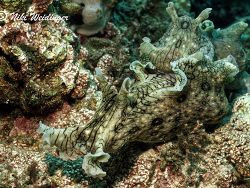Info
Aplysia argus Rüppell & Leuckart, 1830
Aplysia argus have large dark brown-black rings on the mantle and parapodia.The rings can be a pale brownish.
Note: Note
This is the Indo-Pacific species that was earlier called Aplysia dactylomela - the range of which is, however, restricted to the tropical and subtropical Atlantic.
Synonymised names:
Aplysia (Tethys) benedicti Eliot, 1900
Aplysia angasi G. B. Sowerby I, 1869
Aplysia annulifera Thiele, 1930
Aplysia benedicti Eliot, 1900
Aplysia fimbriata A. Adams & Reeve, 1850
Aplysia odorata Risbec, 1928
Aplysia operta Burne, 1906
Aplysia radiata Ehrenberg, 1831
Aplysia scutellata Ehrenberg, 1831
Aplysia tigrina Rang, 1828
Aplysia velifer Bergh, 1905
Syphonota viridescens Pease, 1868
Sea hares feed on algae. They eat various types of algae, kelp and seaweed. In the process, plant parts are rasped off with the rasping tongue (radula). Microscopic food particles are also ingested with the algae. They are often used in aquaristics for algae problems, but with the end of their food they also get nutritional problems.
For protection against predators there are some species that additionally store the toxin aplysiatoxin. This aplysiatoxin is a product of cyanobacteria, which grow on certain types of seaweed. These are ingested along with the algae.
Sea hares are good algae eaters after a usually difficult acclimation period and are also not very picky about the algae. When acclimating, be sure to use the droplet method, as they are extremely sensitive to density fluctuations.
Thus, in addition to the usual filamentous algae, Wrangelia argus and so-called smear algae are often not spurned.
If no more algae are present, then it does not take long and the ea hare starves to death.
However, you can also offer it over-scalded lettuce as a substitute food, but then you should also looka for a substitute home.
Attention, important:
If you want to keep a sea hare, be sure to provide shelter so they don't get caught in a flow pump and shredded.
Dying sea hares are capable of causing the entire fish and crustacean population to die within a short period of time.
If the dead sea hare is not discovered in time, it is imperative to perform a very generous water change and additionally filter with charcoal to filter out the released toxins
Aplysia argus have large dark brown-black rings on the mantle and parapodia.The rings can be a pale brownish.
Note: Note
This is the Indo-Pacific species that was earlier called Aplysia dactylomela - the range of which is, however, restricted to the tropical and subtropical Atlantic.
Synonymised names:
Aplysia (Tethys) benedicti Eliot, 1900
Aplysia angasi G. B. Sowerby I, 1869
Aplysia annulifera Thiele, 1930
Aplysia benedicti Eliot, 1900
Aplysia fimbriata A. Adams & Reeve, 1850
Aplysia odorata Risbec, 1928
Aplysia operta Burne, 1906
Aplysia radiata Ehrenberg, 1831
Aplysia scutellata Ehrenberg, 1831
Aplysia tigrina Rang, 1828
Aplysia velifer Bergh, 1905
Syphonota viridescens Pease, 1868
Sea hares feed on algae. They eat various types of algae, kelp and seaweed. In the process, plant parts are rasped off with the rasping tongue (radula). Microscopic food particles are also ingested with the algae. They are often used in aquaristics for algae problems, but with the end of their food they also get nutritional problems.
For protection against predators there are some species that additionally store the toxin aplysiatoxin. This aplysiatoxin is a product of cyanobacteria, which grow on certain types of seaweed. These are ingested along with the algae.
Sea hares are good algae eaters after a usually difficult acclimation period and are also not very picky about the algae. When acclimating, be sure to use the droplet method, as they are extremely sensitive to density fluctuations.
Thus, in addition to the usual filamentous algae, Wrangelia argus and so-called smear algae are often not spurned.
If no more algae are present, then it does not take long and the ea hare starves to death.
However, you can also offer it over-scalded lettuce as a substitute food, but then you should also looka for a substitute home.
Attention, important:
If you want to keep a sea hare, be sure to provide shelter so they don't get caught in a flow pump and shredded.
Dying sea hares are capable of causing the entire fish and crustacean population to die within a short period of time.
If the dead sea hare is not discovered in time, it is imperative to perform a very generous water change and additionally filter with charcoal to filter out the released toxins







 Javier Couper (Predomalpha), New Zealand
Javier Couper (Predomalpha), New Zealand




























